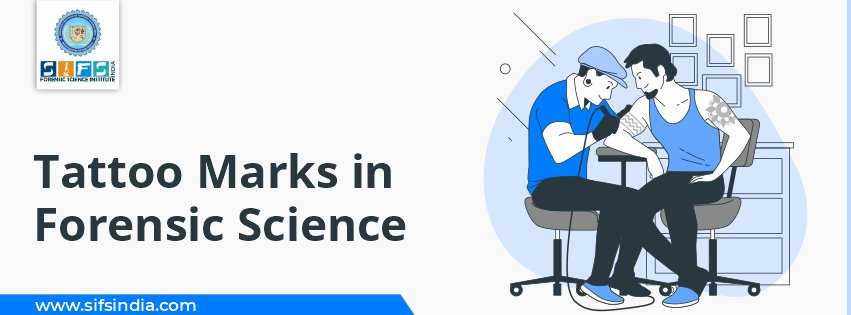- Call Us: +91 7303913002
- Email Us: education@sifs.in
Tattoo Marks in Forensic Science

BY SIFS India | February 09, 2022
Tattoo Marks in Forensic Science
“A picture is worth a thousand words”, so make sure to have it under your skin.
What does it mean?
This is a question routinely answered by tattooed people.
The answers may lead to a plethora of possibilities with potential forensic value.
In 1991, the body of Ötzi, the Iceman was discovered in the Italian alps. The body dated from the Bronze Age had 61 tattoos.
Speculation about the alleged therapeutic role of his tattoos was raised. Another reason to justify the application of ink/pigments under the skin comes from the Roman empire, in which slaves and criminals were marked.
Differently, in the last decades, tattoos became a common form of art and expression.
A recent survey with over 9.000 individuals revealed that 38% had at least one or more tattoos. The frequency was higher (46-48%) in Italy, Sweden, and the US.
Tattoo Relevancy in Criminal Investigation
Finding the exact same tattoos in different individuals is an exceptional phenomenon since the most generic drawings can hardly be reproduced by the same artist.
Moreover, even if perfectly reproduced, the tattoos would hardly be placed in the exact same anatomic region.
The potential individuality of tattoos may add value to human identification.
According to the Disaster Victim Identification Guide of the International Criminal Police Organization (INTERPOL), tattoos figure a secondary means for human identification.
In practice, it means that tattoos may narrow down antemortem (AM) lists of missing persons and guide the identification process to primary means, namely ridgeology, odontology, and genetics (and, more recently, batch numbers of medical appliances).
KMD’s PlassData DVI system for human identification has fields that are dedicated to the register of tattoos in both AM (yellow) and postmortem (PM, pink) forms.
In particular, the file manager tool allows the inclusion of tattoos together with other individual details (of major relevance) of the victim.
Further on AM form 404, the operator can input “specific details” such as tattoos, scars, piercings, skin marks, malformations, and amputations and their respective anatomic region.
Other forensic tools established to improve the analysis of tattoos came with the classification system proposed by the Data Format for the Interchange of Fingerprint, Facial, Scar Mark & Tattoo (SMT) Information (part of ANSI/NIST ITL 1–2000).
The system set 8 pattern descriptors, namely:
1. Human Forms & Features
2. Animals & Animal Features
3. Plants
4. Flags
5. Objects
6. Abstractions
7. Insignias & Symbols
8. Other Images
Within the descriptors in class II, subclasses (i.e. cats & cat heads, dogs & dog heads, and other domestic animals) and subclass codes (e.g. CAT, DOG, BIRD among other 9 are provided) are available.
Organizing data for more reliable and straightforward reconciliation is an essential step into the human identification process. The development of these systematic tools is an example of how tattoos are relevant to the forensic sciences.
A more comprehensive value to the forensic field may come from tattoos with names, dates, portraits, tribal symbols, and even geographic coordinates including latitude and longitude.
All these traces can build up effective biological profiles of victims.
Forensic experts may argue that tattoos do not resist soft tissue degradation.
It must be noted, however, that the ink is placed at the dermal depth, 6 which makes the drawing visible even after superficial starching, exposure to heat, and blunt trauma.
Interestingly, the tattoos of a victim may be known not only by partners, close friends, and relatives but also by people in social media – since the photographic registration of the tattoo (art) is a common practice.
Hence, social media becomes an indirect source of AM data. Forensic experts must be aware of the forensic importance of tattoos and must not overlook art during the autopsy.
Submitted In- "Aalekh; The Art of Writing" (An Initiative of SIFS India).
References
1. Egelking C. Scientists Have Mapped All of Ötzi the Iceman's 61 Tattoos. 2015. Available at: discovermagazine.com
2. Dalia Research. Who has the most tattoos? It’s not who you’d expect. 2018. Available at: medium.com
3. International Criminal Police Organization. Disaster victim identification guide. Lyon: INTERPOL; 2018.
4. ANSI/NIST-ITL 1-2000. INTERPOL implementation (int-I) Available at: nist.gov
5. Brookes GK, Thompson T. The impact of personal perception on the identification of tattoo pattern in human identification. Journal of Forensic and Legal Medicine. 2019;64:34-41.
6. Miranda MD. Forensic Analysis of Tattoos and Tattoo Inks. Boca Raton: CRC Press; 2016.
